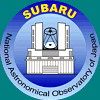The Orion Nebula M42
- 1. AAT Telescope
- 2. Hubble Space Telescope
- 3. Subaru Telescope
Subaru sees "First-Light"!

Orion Menu -
Orion Objects
The Orion Nebula M42
|
Subaru sees "First-Light"!
|
| Click the images to view them in more detail. |
|
THE ORION NEBULA.
This is
an infrared image of the the famous Orion nebula (Messier 42), located 1500
light years away. At the center of the image is the Trapezium, a group of four
bright stars. Many stars seen around the Trapezium are young stars embedded in
the Orion molecular cloud located behind the Orion nebula. Many of them are
seen only at infrared wavelengths. Above the Trapezium, a butterfly-like red
feature is seen in the image, containing the Kleinman-Low (KL) nebula which is
deeply embedded in the Orion molecular cloud. At the center of the KL nebula is
a star called IRc2, which is in the process of forming. This star is believed to be
30 times more massive than the Sun, and its activities are the cause of the big
butterfly feature. Blue, faint, and diffuse emission extending over the entire
region is due to hot gas ionized by strong ultraviolet radiation emitted by the
Trapezium stars. The bright bar seen in the lower left part of the image is an
ionization front. |
|
THE ORION KL REGION.
This is
an enlarged image of the region around the Kleinman-Low nebula in the Orion
cloud located 1500 light years away. This image is taken in light at 2.12 micron,
which is emitted by warm molecular hydrogen gas with an absolute temperature
of 2000 K. This is Subaru's first image in the light of a single emission line,
demonstrating its high resolution capability. Although not seen in this image, at
the center of the giant butterfly-like feature is IRc2, a star 30 times more massive
than the sun which is in the process of forming. A strong wind with a speed of
more than 100 kilometers per second is blowing out from IRc2, evacuating the
butterfly-like cavity and allowing infrared light to escape. Many finger-like
features are seen radially emanating from the Orion KL region, produced when
the strong stellar wind from IRc2 collides with the surrounding cold material,
heating it to around 2000 K and causing the hydrogen molecules to emit light.
|